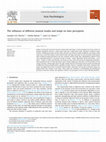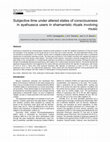Papers by Leandro Augusto Santos Pereira

Leandro A. S. Pereira, Danilo Ramos, José L. O. Bueno, 2022
Studies involving the interaction between musical mode and tempo on time perception have been car... more Studies involving the interaction between musical mode and tempo on time perception have been carried out through comparisons between a single major mode and a single minor mode, presented in different tempi. However, classifying the modes only into major and minor has not been considered sufficient. The purpose of this study was to verify the influence of the musical mode and tempo interaction on time perception analyzing the effect of different modes performed in the slow, moderate and fast tempi. Fifty undergraduate students of both sexes individually listened to 12 musical excerpts (4 modes-Ionian, Mixolydian, Dorian and Aeolianand 3 tempi-72 bpm, 114 bpm, and 184 bpm), one excerpt at a time. After each excerpt, the participants performed a time-reproduction task, in which they had to press a button (beginning of the task), recal the duration of each excerpt and press a button again (end of the task). Results showed no interaction between mode and tempi and no differences between musical modes, regardless of tempo. However, regardless of the mode, excerpts in slow tempo was judged shorter than in moderate and fast tempi, respectively, and excerpts in moderate tempo was judged shorter than excerpts in fast tempo. These results can contribute to understanding the psychological processes of attention, memory and expectancy related to the perception of time in music listening situations.

Brazilian Journal of Medical and Biological Research
Ayahuasca is described as a hallucinogenic substance whose property is to alter the subjective ex... more Ayahuasca is described as a hallucinogenic substance whose property is to alter the subjective experience of time and impair the perception of the passage of time during stimuli of more than two to three seconds. The dose-dependent effects of two concentrations of ayahuasca in the ritualistic context were investigated employing temporal reproduction tasks in participants experienced in shamanistic ayahuasca rituals. The study was conducted on nine healthy volunteers who ingested two doses of ayahuasca at two times during a ritual session. The doses of each session, consumed in amounts ranging from 20 to 60 mL, were either of low concentration or of experimental ayahuasca according to a double-blind procedure. Participants performed the task of immediately listening and reproducing, with a laptop, 20-s musical stimuli during the session. The results showed that significant temporal distortion was triggered by the musical stimulus presented without the ingestion of ayahuasca, with means of 16.33 to 16.52 s. There were minor temporal distortions after ingestion of ayahuasca: a mean of 17.91 s for control ayahuasca and of 18.38 s for experimental ayahuasca. These results with less temporal distortion among participants with ayahuasca intake disagree with other studies of hallucinogens involving temporal reproduction.

Subjective time under altered states of consciousness in ayahuasca users in shamanistic rituals involving music, 2020
Ayahuasca is described as a hallucinogenic substance whose property is to alter the subjective ex... more Ayahuasca is described as a hallucinogenic substance whose property is to alter the subjective experience of time and impair the perception of the passage of time during stimuli of more than two to three seconds. The dose-dependent effects of two concentrations of ayahuasca in the ritualistic context were investigated employing temporal reproduction tasks in participants experienced in shamanistic ayahuasca rituals. The study was conducted on nine healthy volunteers who ingested two doses of ayahuasca at two times during a ritual session. The doses of each session, consumed in amounts ranging from 20 to 60 mL, were either of low concentration or of experimental ayahuasca according to a double-blind procedure. Participants performed the task of immediately listening and reproducing, with a laptop, 20-s musical stimuli during the session. The results showed that significant temporal distortion was triggered by the musical stimulus presented without the ingestion of ayahuasca, with means of 16.33 to 16.52 s. There were minor temporal distortions after ingestion of ayahuasca: a mean of 17.91 s for control ayahuasca and of 18.38 s for experimental ayahuasca. These results with less temporal distortion among participants with ayahuasca intake disagree with other studies of hallucinogens involving temporal reproduction.








Uploads
Papers by Leandro Augusto Santos Pereira